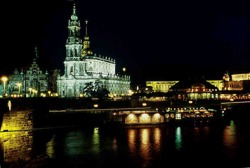
The Elbe Valley in Dresden is at risk of being removed from the UNESCO World Heritage sites
 |
According to experts, the bridge would disrupt the baroque silhouette of the city, recently painstakingly restored by the reconstruction of the famous Church of Our Lady (Frauenkirche), which was destroyed during World War II. The authorities in Dresden now have until a similar UNESCO conference next year to propose a solution for the link between both banks of the river that would meet the requirements of world cultural heritage status. Conversely, if the city were to construct the controversial bridge near the Forest Castle as it has been advocating so far, the Elbe lowlands would likely be removed from the UNESCO world cultural and natural heritage list as early as 2007. This would mark the historic first case of removal from this prestigious list, which currently includes 812 sites.
In contrast, the western German city of Cologne celebrated success when its famous Gothic cathedral was removed from the "red" list of UNESCO endangered sites on the same day, allowing it to maintain its status as a world heritage site. It was placed on the endangered list in 2004 after the city planned the construction of several skyscrapers, among which the cathedral would literally be "drowned" in the city silhouette. However, Cologne's city council brought three proposals to the current conference in Vilnius on how to preserve the dominant position of the significant 13th-century monument and the city's panorama, including reducing the maximum height of four new buildings from 100 to about 60 meters.
"The UNESCO commission's decision regarding Dresden is clear. It would be advisable to take it seriously," said the head of the German delegation at the Vilnius conference, Walter Hirche, to the DPA agency. It is generally expected that Dresden will find a solution that will satisfy UNESCO experts.
"Being placed on the red list of endangered sites UNESCO has a similar function as a yellow card in football: if you don't stop misbehaving, you will be sent off the field," characterized the situation DPA. Being inscribed on the endangered list can result not only from deliberate destruction and uncontrolled urbanization but also from mismanaged tourism, industrial pollution, natural disasters, or war, as was the case in 1991 with Dubrovnik. After seven years of restoration, it was removed from the "red" list again.
The conference will also address a proposal from the Polish side to officially designate the notorious extermination camp in Auschwitz as the "former Nazi German concentration camp Auschwitz-Birkenau." Poland aims to emphasize that it had nothing to do with the establishment and operation of this unfortunate institution, in which approximately 1.5 million people, primarily Jews, were murdered during World War II. With the gradual dying off of war witnesses, the typical labeling of "Auschwitz concentration camp in (present-day) Poland" or even "Polish concentration camp Auschwitz" has been creating the impression among younger people that it was built by Poles, and its association with German Nazism has faded from public knowledge.
The conference, which will last until Sunday in the Lithuanian capital, will also decide on the potential expansion of the existing world heritage list. Over 800 delegates from around the world are participating. Of the more than 800 items already on the world cultural heritage list, the Czech Republic has 12 sites.
The English translation is powered by AI tool. Switch to Czech to view the original text source.
0 comments
add comment






